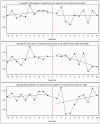Response to a peer telehealth intervention for emergency department patients presenting with opioid use disorder or unintentional overdose: a stratified interrupted time series analysis
- PMID: 40382632
- PMCID: PMC12085845
- DOI: 10.1186/s13011-025-00650-0
Response to a peer telehealth intervention for emergency department patients presenting with opioid use disorder or unintentional overdose: a stratified interrupted time series analysis
Abstract
Background: People in the United States who use opioids frequently use emergency department (ED) services. Some hospitals have begun placing peer recovery support specialists (PRSS) in EDs to support and advocate for patients and provide linkages to services, in an effort to reduce future presentations for opioid-related and other health problems related to substance use. However, evidence supporting the impact of PRSS services on reducing future ED presentations is limited, and even less is known about ED-based PRSS services delivered via telehealth.
Methods: Using records from a large Indiana-based hospital system, we conducted an interrupted time series (ITS) analysis of ED patients presenting for unintentional opioid overdose or other opioid-related issues. Over a five-year period, 2,542 unique ED visits were included across 12 hospitals. The primary outcome assessed was the impact of PRSS telehealth service implementation (comparing pre- and post-periods) on 30-day all-cause ED revisits. Analyses were also stratified by appropriate demographics.
Results: There was no significant change in 30-day ED revisits between pre- and post-implementation of the PRSS telehealth program. Results of sex-stratified ITS indicated a significant change for females only, with decreasing log-odds of ED revisits post-program implementation (post-implementation slope OR = 0.911, p = 0.031; slope change OR = 0.874, p = 0.017).
Conclusions: Although there was no detectable difference in overall ED revisits following program implementation, outcomes of stratified analyses suggested that the program may have been more impactful for females vs. males. Future research should examine the underlying mechanism of the observed sex differences to target behavioral change more effectively for all participants of telehealth PRSS services in ED settings.
Keywords: Emergency department; Interrupted time series; Opioid use disorder; Peer recovery support; Telehealth.
© 2025. The Author(s).
Conflict of interest statement
Declarations. Ethics approval and consent to participate: Due to the limited nature of the dataset used, the study was determined not to meet requirements for human subject research review (Indiana University IRB #2006108993). Consent for publication: Not applicable. Competing interests: The authors declare no competing interests.
Figures
Similar articles
-
Results From the POINT Pragmatic Randomized Trial: An Emergency Department-Based Peer Support Specialist Intervention to Increase Opioid Use Disorder Treatment Linkage and Reduce Recurrent Overdose.Subst Use Addctn J. 2024 Jul;45(3):378-389. doi: 10.1177/29767342231221054. Epub 2024 Jan 9. Subst Use Addctn J. 2024. PMID: 38258819 Free PMC article. Clinical Trial.
-
Emergency Department Peer Support Program and Patient Outcomes After Opioid Overdose.JAMA Netw Open. 2024 Mar 4;7(3):e243614. doi: 10.1001/jamanetworkopen.2024.3614. JAMA Netw Open. 2024. PMID: 38526490 Free PMC article.
-
Interventions for preventing abuse in the elderly.Cochrane Database Syst Rev. 2016 Aug 16;2016(8):CD010321. doi: 10.1002/14651858.CD010321.pub2. Cochrane Database Syst Rev. 2016. PMID: 27528431 Free PMC article.
-
Psychological therapies for post-traumatic stress disorder and comorbid substance use disorder.Cochrane Database Syst Rev. 2016 Apr 4;4(4):CD010204. doi: 10.1002/14651858.CD010204.pub2. Cochrane Database Syst Rev. 2016. PMID: 27040448 Free PMC article.
-
Implementation of a peer-delivered opioid overdose response initiative in New York City emergency departments: Insight from multi-stakeholder qualitative interviews.J Subst Use Addict Treat. 2025 Jan;168:209542. doi: 10.1016/j.josat.2024.209542. Epub 2024 Oct 21. J Subst Use Addict Treat. 2025. PMID: 39442627
References
-
- CDC. Opioid data analysis and resources. 2023 [cited 2023 Sep 5]. Available from: https://www.cdc.gov/opioids/data/analysis-resources.html
MeSH terms
Grants and funding
LinkOut - more resources
Full Text Sources
Medical



